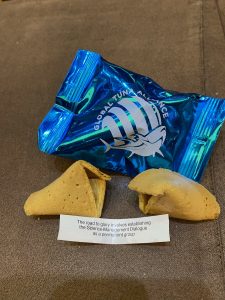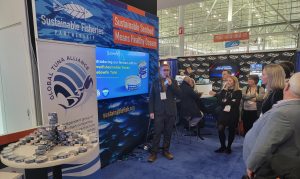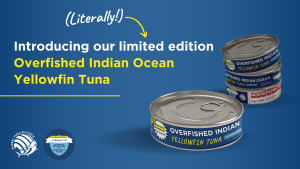So – A fortune cookie, an empty tuna can, and a postcard walk into a bar*…
Our Creative Comms Officer, Joe Nutt, discusses how MWC creates attention-grabbing advocacy campaigns for the Global Tuna Alliance.
Are you paying attention? Attention seems an easy enough thing to offer, but in a loud and crowded market, figuring out how to get people’s attention is a stubborn question for campaigners and marketers. But in our role as the comms branch of the Global Tuna Alliance, it’s clear that delivery of the message can often be more significant than the message itself.
Are you paying attention?
If you enjoy high pressure decision-making with near-impossible manoeuvring to keep everyone happy, you could consider life as a tuna Regional Fisheries Management Organisation (tRFMO) delegate. You’ll take critical decisions about the future management of tuna fisheries that will affect the health of one of the most commercially valuable fish species in the world, all the while balancing a torrent of voices and vested interests trying to impress their own point of view on you. This could include people from the state you represent, fishers, the supply chain, retailers, consumers, scientists or NGOs. But – let’s be honest – it’s usually all of the above.
The GTA – a pre-competitive, independent association of seafood supply chain companies and retailers with a shared interest in advancing sustainable tuna fishing – was designed as a solution to the problem of disunited and disparate voices in the market getting drowned out at RFMO meetings. The GTA tasked Mindfully Wired with the challenge of cutting through the noise and making the market’s presence at these crunch meetings unmissable.
The only way we could be absolutely sure that RFMO delegates were paying attention was to place the message right in front of their face.
Fortune favours the bold
Western Central Pacific Ocean Tuna – 2022.
The return of in-person at the Western-Central Pacific Fisheries Commission (WCPFC) meeting last December in Da Nang, Vietnam presented a unique opportunity to do just that.
 The message? To encourage WCPFC to adopt harvest strategies to protect the perfect ‘green’ status of all of its stocks. The delivery method? We decided to harness the fact that the fate of tuna, its destiny and future, was in the hands of delegates. So, we created our own fortune cookies, placed in front of the chairs of each delegate at the meeting venue by the GTA’s Director. The key message behind this highly technical and science-driven campaign was a real mouthful – so we made it a real mouthful.
The message? To encourage WCPFC to adopt harvest strategies to protect the perfect ‘green’ status of all of its stocks. The delivery method? We decided to harness the fact that the fate of tuna, its destiny and future, was in the hands of delegates. So, we created our own fortune cookies, placed in front of the chairs of each delegate at the meeting venue by the GTA’s Director. The key message behind this highly technical and science-driven campaign was a real mouthful – so we made it a real mouthful.
Playfulness was at the forefront of this stunt, with message slips fusing traditional, prophecy-esque fortunes with the direct, specialised asks of the GTA to create a series of sharp-tongued, action-focused messages, packaged in a GTA-branded wrapper.
The next day, the GTA’s Director returned to hand out postcards, containing our key campaign visual – an illustration of the real possibility of the WCPFC losing the ‘all-green’ status they’re so proud of. The postcard visualised a billboard in the future displaying this iconic RFMO bar-graph, with someone painting over the all-green bar for the WCPFC, and the on-the-nose comment “it’s a shame they didn’t implement harvest strategies”. A side-event organised by the GTA and NGO Tuna Forum at the meeting venue in which a video of statements from the GTA’s market partners played on loop in the background completed what was an extremely focused, targeted in-person campaign.
At the end of the week-long meeting, with the crumbs of the cookies still dusting the delegates’ desks, their prophecies lingering in the air, WCPFC made history by adopting its first-ever harvest strategy.

While it’s tricky to measure the impact this campaign had on the outcome, the GTA’s activities were widely acknowledged, with the Japan delegate commenting, “in the past people who were in charge of negotiations were not really aware of voices from the market… [but] the power of the market is becoming stronger every year.” The Cook Islands’ Head of Delegation also tweeted a photo of her fortune cookie with the caption “Bravo @GlobalTuna, you have won first prize for my favourite ever RFMO delegate gift. Inspired!”
The profile of the market at the meeting was well and truly raised!
Where’s the tuna gone?
Indian Ocean Tuna – 2023.

The overfishing of Indian Ocean yellowfin tuna since 2015 is an ecological travesty but one that doesn’t get talked about a lot in the media. In a sign of the times we’re in, the overexploitation of a resource to near extinction just doesn’t seem new, and getting the public to care requires outside-the-box thinking.
To really draw attention to the problem, we subverted modern-day marketing campaigns that promise sustainability to assuage the guilt consumers may feel about their impact on the environment.
Studying a few product labels, it’s hard to avoid the certification badges, the “sustainably sourced” messages, or the commitments to offset carbon. But how do you market Indian Ocean yellowfin tuna when it’s been overfished for eight years?
Our suggestion was to send the GTA to one of the world’s biggest annual seafood expositions in Boston, armed with 100 fake cans of tuna to do a pretend “product launch”. And that’s exactly what they did! The overly honest satirical label on these cans completely flipped expectations.
Take the “Guaranteed overfishing occurring or your money back” notice or the ‘nutritional label’ that instead shows year-on-year the overfished status of yellowfin. The label is packed with small details that highlights the dire state of yellowfin tuna in the Indian Ocean and raises awareness of the GTA’s campaign to rebuild the stock. The cans were empty – a poignant symbol in itself – aside from a piece of paper asking “where’s the tuna gone?” along with a QR code directing people to a landing page on the GTA website where they could learn more.

The stunt succeeded in picking up press attention and generating thousands of views and engagements on the GTA’s social media. But the highlight was still witnessing a group of bemused exposition attendees at the product launch open their cans cautiously as though they were about to spill brine everywhere. Old habits die hard!
A second glance

Attention may seem like an easy thing for us to offer. But for an overwhelmed decision-maker caught in a fine balancing act between a deluge of competing interests, or for an ordinary member of the public inundated by requests to support various, seemingly-identical environmental campaigns – there’s a constant battle to stand out among the rest.
What our campaigns with the GTA have shown is that out-of-the-ordinary methods for delivering a message – piquing curiosity to the point that someone can’t help but open up an unusual object to find the message inside -can be a game-changer.
You may ask the question, “where does the GTA go from here?” Skywriting? A flash mob? A West End production of ‘Rebuild Yellowfin Tuna 2: Here we go again!’? The answer isn’t what matters. What matters is that you’re now curious enough to ask the question.
*Okay so “Bar” = RFMO meeting, but would you have read the blog if we’d said the latter?
